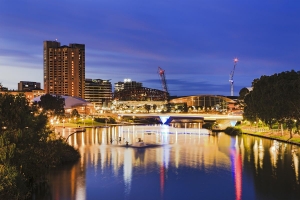Published by The Australian, Monday 26 September
This winter South Australia got an electricity shock. On the evening of July 7, the wind wasn’t blowing, the sun wasn’t shining, and the interconnector that supplies power from Victoria was down. Gas set the wholesale price, and gas is expensive, especially during a cold winter. At 7.30pm wholesale spot prices soared to $9000 per megawatt hour. For the month they averaged $230 a megawatt hour, when they were closer to $65 in the rest of the country.
The prices alarmed the state government and outraged big industrial consumers, who buy power on the wholesale market. Commentators hunted for a culprit: wind power, gas generators, the market itself. Everyone demanded that something be done.
Yet, as shown by Grattan Institute’s latest report, Keeping the lights on: lessons from South Australia’s power shock, the market worked. Prices soared then fell back, power was delivered, the lights stayed on. Yet South Australia’s power shock exposed a looming problem in the electricity system — not high prices or the threat of blackouts, but a glimpse of what can happen when climate change policies and the demands of the energy market conflict.
Australia is committed to reduce greenhouse gas emissions by 26 to 28 per cent below 2005 levels by 2030. Yet despite this ambitious target, almost no policy remains to reduce emissions from the power sector. By 2014 the maligned renewable energy target, a Howard government industry policy of sorts to support renewable energy, remained as the only policy with any real impact on the sector’s emissions.
The RET is particularly favourable to wind power, forcing it into a market where demand is falling. In South Australia wind supplies 40 per cent of electricity. Its ability to generate power at zero marginal cost suppressed wholesale prices in the state and forced the shutdown of all coal plants and the mothballing of some gas plants. Yet wind is intermittent — it generates power only when it is blowing, and on July 7 it barely was.
The clearest sign that the market worked was that there were “no system security or supply reliability issues in South Australia during the month” and “no departures from normal market rules and procedures,” according to the Australian Energy Market Operator. It is true that gas generators operating during July may have made a lot of money. But sometimes generators legitimately use their market power in order to make profits they are unable to make when the price is low. If they could not do so, they would not invest in the first place.
Yet while the events of July do not expose an immediate crisis, they reveal the potential consequences of a disconnection between climate change policy and energy markets. If it is not addressed, the goals of reliable, affordable and sustainable energy may not be achieved.
Climate change policy should work within and not outside the electricity market. The RET has increased levels of renewable energy in the market, but forcing in new intermittent capacity creates problems not foreseen when traditional generation from coal and gas supplied the bulk of Australia’s power needs.
One concerns the efficient dispatch of existing generation, the other the difficulty of providing clear price signals for investment and divestment. The events in South Australia exposed both problems, showing that a large proportion of wind farms can be off line at the same time. The problem can be solved by investment in storage and in flexible responses such as gas and other fast-start generators. Yet suppressed wholesale prices combined with price spikes when demand outstrips faltering supply is not the way to encourage long-term investors.
Never waste a near crisis. The COAG Energy Council of federal and state energy ministers acknowledges the need for national policy integration. Meeting that need requires a credible and predictable climate change policy, then a review of the wholesale market to ensure it provides reliable, competitively priced electricity.
Josh Frydenberg, federal Minister for Environment and Energy, has a job to do and, after South Australia’s near crisis, the ammunition he needs in order to do it.
 Published by
Published by